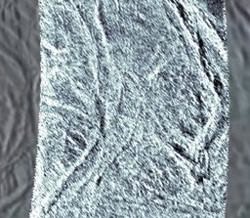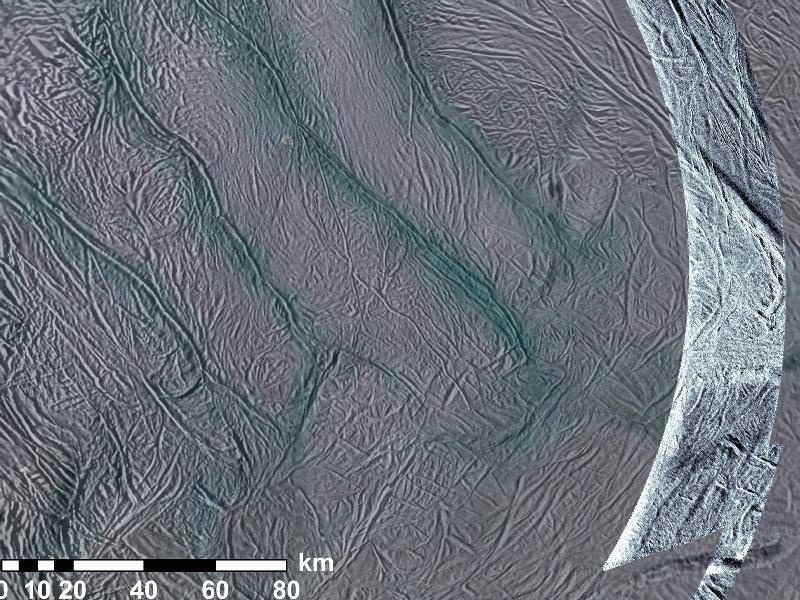[/caption]
Cassini’s done it again! Soaring over Saturn’s moon Enceladus back on November 6, the spacecraft obtained the highest-resolution images yet of the moon’s south polar terrain, revealing surface details with visible, infrared and radar imaging that have never been seen before.
Of particular interest are new image swaths acquired by the spacecraft’s synthetic-aperture radar (SAR) instrument, which has never before been used on Enceladus. The radar, which is highly sensitive to surface textures, reveals some extremely bright regions that have surprised scientists.

“It’s puzzling why this is some of the brightest stuff Cassini has seen,” said Steve Wall, deputy team lead of Cassini’s radar team based at NASA’s Jet Propulsion Laboratory in Pasadena. “One possibility is that the area is studded with rounded ice rocks. But we can’t yet explain how that would happen.”
The SAR images did not focus on the moon’s now-famous “tiger stripe” fractures (called sulci) which are the sources of its icy jets. Instead, Cassini scanned areas a few hundred miles around the stripes. These regions have not been extensively imaged before and this new data shows surface patterns and elevations that had been previously unknown.
Some of the steep grooves in the imaged areas were shown to be as deep as 2,100 feet (650 m), and 1.2 miles (2 km) wide.
Cassini passed by the 318-mile (511-km) -wide moon at 04:49 UTC on November 6, 2011. Cassini’s radar instrument was built by JPL and the Italian Space Agency, working with team members from the U.S. and several European countries. Previously used to image the surface of Titan, which is hidden from view by a thick atmosphere, this is the first time the instrument was used on Enceladus.
Here’s a video from the imaging team below:
See the news release on the NASA mission page here, or on the Cassini mission page maintained by JPL.


Wouldn’t it be more likely pitted ice (say, micrometeorite impacts) for high reflectivity ice surfaces?
But if it is indeed rounded ice, it could be some form of aggregation (analogous to condensation of cloud liquids or even ices around condensation cores). Enceladus plows its own ice track, for one.
Then the question could become: how old is the plumes? They should be able to extract the average size of those reflectors, I hope.
The song is red eye love.
http://en.wikipedia.org/wiki/File:Radar_love.jpg
uh, no it’s not….. Classic Golden Earring. Last car to pass, here I go…..
Gotta keep cool now, gotta take care…
you don’t talk about the surface itself much, other than to note some bright spots. AFAIK, it’s unique among all known planetary landscapes. Obviously resurfaced lately, and looking for all the world like newly crusted ice on a pond. Scientists get all excited over pitted, typical Mercury and Vesta but this is what I call interesting. Something that in no way resembles a tired old space rock! And without an atmosphere!
The rings of Saturn are ice-fed by Enceladus by strong magnetical coupling. And that’s the reason why there’s no atmosphere. Everything gets drained out south. The inner moon might be thermically very active by this same proces, and liquid water might be well present under the ice layer. Chances for primitive sea life are apparent… When will we find out?
Looks like Europa.
In the first still after the opening ID screen it looks just like New York state Finger Lakes area
The first still after the introduction screen looks just like New York State Finger Lakes region